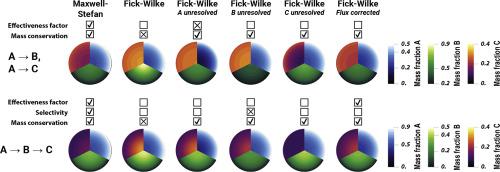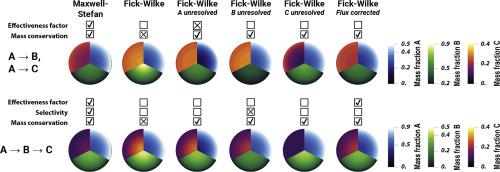单一反应粒子中多组分扩散模型的比较
IF 4.3
2区 工程技术
Q2 ENGINEERING, CHEMICAL
引用次数: 0
摘要
催化颗粒通常出现在化学工业的许多多相反应器中。颗粒中的输运反应行为对反应器的整体性能有重要影响。在这项工作中,粒子的扩散输运用严格的麦克斯韦-斯特凡方程和简单的菲克-威尔克扩散来模拟。考虑到速率常数和二元扩散系数的变化,将几种菲克-威尔克公式与具有平行或连续反应方案的三元体系的麦克斯韦-斯蒂芬模型进行了比较。这些包括:(1)分解所有组分的公式,(2)不分解其中一个组分的三个变体,以及(3)执行质量守恒的通量修正变体。然而,它们不能准确地捕捉整个行为范围,也不能同时准确地捕捉有效性因素和选择性。研究重点是一个简化的等摩尔体系,以隔离扩散闭合的作用;讨论了麦克斯韦-斯蒂芬公式的局限性、计算方面以及未来推广的方向。本文章由计算机程序翻译,如有差异,请以英文原文为准。


Comparison of multi-component diffusion models in a single reactive particle
Catalytic particles commonly appear in many multiphase reactors in the chemical industry. The transport-reaction behaviour in the particle has a significant impact on the overall reactor performance. In this work, the diffusive transport in the particle is modelled with the rigorous Maxwell-Stefan equations and simple Fick-Wilke diffusion. Several Fick—Wilke formulations are compared to the Maxwell—Stefan model for a ternary system with either a parallel or consecutive reaction scheme, considering variations in rate constants and binary diffusion coefficients. These include: (1) a formulation that resolves all components, (2) three variants in which one component is not resolved, and (3) a flux-corrected variant that enforces mass conservation. However, they are incapable of accurately capturing the whole range of behaviours or simultaneously capturing the effectiveness factor as well as the selectivity accurately. The study focuses on a simplified equimolar system to isolate the role of the diffusion closure; limitations, computational aspects of the Maxwell—Stefan formulation, and directions for future extensions are discussed.
求助全文
通过发布文献求助,成功后即可免费获取论文全文。
去求助
来源期刊

Chemical Engineering Science
工程技术-工程:化工
CiteScore
7.50
自引率
8.50%
发文量
1025
审稿时长
50 days
期刊介绍:
Chemical engineering enables the transformation of natural resources and energy into useful products for society. It draws on and applies natural sciences, mathematics and economics, and has developed fundamental engineering science that underpins the discipline.
Chemical Engineering Science (CES) has been publishing papers on the fundamentals of chemical engineering since 1951. CES is the platform where the most significant advances in the discipline have ever since been published. Chemical Engineering Science has accompanied and sustained chemical engineering through its development into the vibrant and broad scientific discipline it is today.
 求助内容:
求助内容: 应助结果提醒方式:
应助结果提醒方式:


